 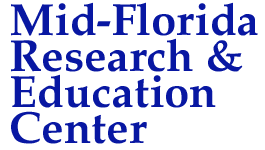 |
  |
| The Pink Hibiscus Mealybug |
|
NEWS Louisiana Infestation: Press release (October 5, 2006) Pink Hibiscus Mealybug Found in Texas (September, 2007) Texas PHM Webpage
|
| QUARTERLY REPORTS
(USDA-AHPIS & FLORIDA DEPARTMENT OF PLANT INDUSTRY) |
|
PHM Quarterly Report October to December, 2007 PHM Quarterly Report July to September, 2007 PHM Quarterly Report April to June, 2007 |
| This
page will change on a regular basis. We update this page as new
information becomes available. For management information: The Pink Hibiscus Mealybug in California |
|
Pink Hibiscus Mealybug Survey PHM Status as of July 27th, 2004 |
|
CLICK here for the General Information PowerPoint Presentation (15.1 MB) CLICK here for the Survey Information PowerPoint Presentation (26.7 MB)
If you click on the Hover Button above with the right button on your mouse, a download dialogue box will open which will allow you to open or save either presentation (it can take a long time). CLICK here to download PowerPoint Viewers
If you would likd a CD, have problems or this version doesn't meet your needs please contact me at: last updates: May 20, 2005 |
| Any comments, suggests
or complaints about this website should be addressed to its developer.
Lance S. Osborne |
| To view a larger version of any photos on this page just click on the photo. All photos are the property of Lance S. Osborne ( lso@mail.ifas.ufl.edu ) and the University of Florida. Please ask permission before using! I would appreciate any comments concerning the content of this page (errors, omissions....). |
|
|
Photograph by: Marshall Johnson, UC Kearney Agricultural Center. |
| This is the Pink
Hibiscus mealybugs, Maconellicoccus hirsutus (Green).
Notice that there is very little wax on the body, no long tails
or waxy projections around the edge, no stripes and this mealybug does
produce an egg mass. When
squashed a pink to red fluid is observed.
None of the other mealybugs described in this page has this color
body fluid. Photograph by: Dale Meyerdirk, USDA, APHIS. APHIS has
produced a document that compares the physical attributes of various
mealybugs. Click
here!
APHIS has also produced a list of plants attacked by PHM. Click here! For a list of plants on which PHM has been found in Florida Click here! |
|
Besides hibiscus, Florida trema or nettletree (Trema micranthum (L.) Blume) is the most commonly invested plant in Florida. |
|
To view a series of Florida trema photos, Click here!
|
| DAMAGE |
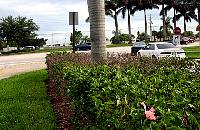
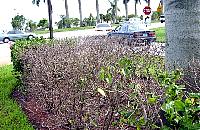
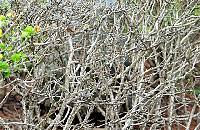 |
| The culmination of a sever infestation is defoliation and death of the infested plant material. In this case it was a hedge of hibiscus. |
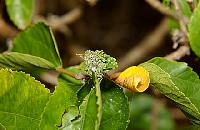
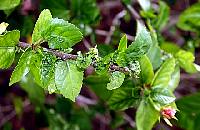
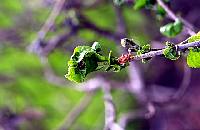
|
| The symptoms of an infestation of PHM on hibiscus would be the distortion of the foliage and flowers. The distance between leaves becomes very short causing the characteristic "Bunchy Top" symptom. |
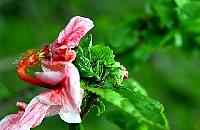
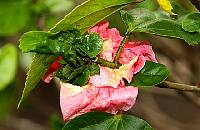 |
|
Damage to the flowers |
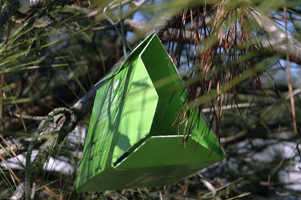 |
|
This is a photo of the green delta trap that contains a capsule impregnated with the PHM female sex pheromone. These traps are currently being evaluated as a monitoring tool. |
| EDITED VERSION OF THE USDA-APHIS - Pink Hibiscus Mealybug Report |
|
DATES: December 28 through February 3, 2003 DPI personnel conducted biometric survey in numerous sections surrounding the Coral Gables find with no additional sections being reported as positive.
To date, records indicate a total of 245 sections in Broward County and 137 sections in Miami-Dade County have been formally surveyed. Positive section totals to date: Broward 66 sections, Miami-Dade 24 sections.
CONTROL: Puerto Rico is shipping approximately 10,000 parasitoids per week. California sent their last shipment the first week of January and is no longer rearing these types of parasitoids.
Personnel from DPI made multiple releases in 36 sections. Releases sites were in the cities of Sunrise, Pembroke Pines, Miramar, SW Ranches, Davie, Coral Gables, unincorporated Miami-Dade, Lauderdale Lakes, Lauderhill, and Weston.
To date, USDA and DPI personnel have made 976 releases in 416 different sites in Miami/Dade and Broward counties. A total of 300,200 parasitoids have been released thus far.
USDA/DPI FFD trapping personnel are continuing PHM survey and outreach efforts with lawn maintenance and landscape crews while performing trapping duties. USDA/DPI personnel continue to analyze and review data for new release sites. |
|
PHM Report DATES: April 21 through July 27, 2004 SURVEY: DPI inspectors and USDA trapping personnel have detected 54 new positive sections since the last PHM Report. The new sections have been found in Miami-Dade, Broward, Palm Beach, Martin, St. Lucie, Pinellas, and Collier Counties. On April 23, PHM was detected in Homestead by a USDA FFD trapper. A survey of Homestead and the surrounding areas was immediately conducted. As a result of the survey, 20 additional STRís in South Miami-Dade County were found to have PHM. Most of the parasitoids are now being released in the environs in the Homestead/South Dade. On July 17, PHM was confirmed in Collier County. An informal survey conducted in the area resulted in five other STRís showing up as positive. A more intensive survey of Collier County and surrounding areas is set to be conducted the first week of August. The following new STRís have been found positive:
Currently nine counties have PHM; 103 positive sections in Miami-Dade County, 152 sections in Broward County, 12 sections in Palm Beach County, three in Martin, three in St. Lucie, one in Indian River, three in Pinellas, six in Collier County, and one in Hillsborough. CONTROL: Puerto Rico continues to ship approximately 10,000 parasitoids per week. Parasitoids continue to be released in all new positive areas. Since the inception of the release program in June of 2002 there have been 967,200 parasitoids released. MISC: On July 1st and 2nd, three representatives from the Cayman Islands Department of Agriculture revisited South Florida to view, first hand, the current status of the PHM program. Presentations of the program relative to parasite release activities, regulation of nurseries and the overall status of the program were provided by DPI and USDA representatives. Also included in the visit were field trips to several nurseries in the Homestead area. USDA/DPI FFD trapping personnel are continuing PHM survey and outreach efforts with lawn maintenance and landscape crews while performing trapping duties. There has been an increase in the number of calls to the PHM HelpLine. All of which are promptly investigated. Prepared by Frank Burgos |
|
PHM Report DATES: May 1 through May 31, 2005 SURVEY: Fifteen new positive sections in Collier, Lee, Miami-Dade, Palm Beach and St Lucie have been detected by FDACS/DPI inspectors and USDA trapping personnel. The new STRís that have been found positive are listed below.
To-date, the number of counties with PHM still remains at thirteen; 11 positive sections in Monroe county, 192 positive sections in Miami-Dade county, 185 sections in Broward county, 31 sections in Palm Beach county, 6 in Martin, 5 in St Lucie, 2 in Indian River, 8 in Pinellas, 8 in Lee, 21 in Collier, 10 in Brevard, 1 in Hillsborough and 2 in Orange county. CONTROL: Presently, California has resumed its weekly shipment of parasitoids to Florida. The quantities received each week vary. Parasitoids are also being shipped from Puerto Rico. This situation will continue until California has achieved full production. To-date, 1,376,500 parasitoids have been released. Prepared by Gangadai Azore |
| MANAGEMENT
To obtain information about managing this pest or to view photos of the biological Control agents |
|
CONTACT YOU LOCAL COUNTY EXTENSION AGENTS FOR GUIDANCE. TO FIND THE PHONE NUMBERS OF YOUR EXTENSION OFFICE OR YOU LOCAL PLANT INSPECTORS CLICK ON THE FOLLOWING: UNIVERSITY OF FLORIDA EXTENSION: http://www.ifas.ufl.edu/extension/index.htm FLORIDA DIVISION OF PLANT INDUSTRY: 1-352-372-3505 PINK HIBISCUS HOT LINE: 1-888-397-1517
|
| Mealybug Links | USDA-APHIS
FLORIDA - DIVISION OF PLANT INDUSTRY
|
| More information on mealybugs can be viewed at "Insect and Related Pests of Flowers and Foliage Plants". Click here! |
|
RETURN TO THE MEALYBUG PAGE TO COMPARE PHOTOS To download a Field Key for ID of arthropods commonly mistaken for pink hibiscus mealybug Click here! |
| All photos are the property of Lance S. Osborne ( lso@mail.ifas.ufl.edu ) and the University of Florida. Please ask permission before using! I would appreciate any comments concerning the content of this page (errors, omissions....). |